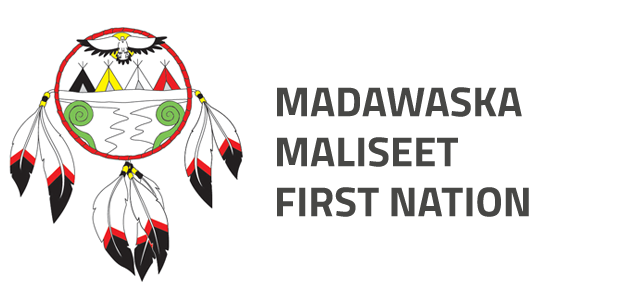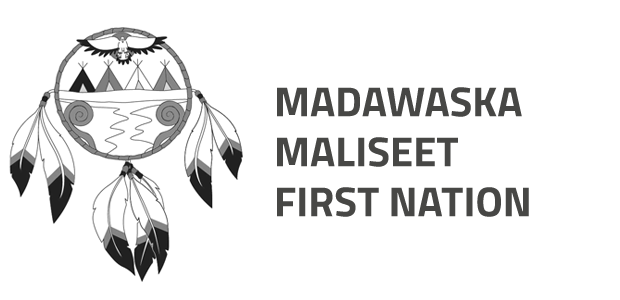Claim Background
Background on the Madawaska Maliseet First Nation Claim
The Specific Claims Tribunal process is a quasi-judicial one (you can learn more about it here), meaning both Canada and the MMFN will submit expert opinion and evidence concerning the validity of – and to determine compensation for – the claim.
This background deals with key dates and events in the life of our community, relating to our claim.
Maliseets have lived on, utilized, and managed this land since time immemorial, which means that they are not settlers in their own land. There has been a Maliseet village at Madawaska, since at least the mid 1700s, it also held importance as the site of the annual Maliseet Grand Council in the late 1700s.
In 1785, a group of Acadian families arrived in Madawaska from Ste. Anne-des-Pays-Bas (today the Fredericton area), looking to relocate after the Loyalist resettlement in New Brunswick. Maliseets and Acadians traditionally were known to each other for many years before the Acadians arrived at Madawaska. Some of the Acadians who came up were fluent in Maliseet as well, testamentary to a historic, social relationship. Thus, it is possible that some of the Acadians and Maliseets who were present at Madawaska in 1785 knew each other on a personal basis.
In 1787, the Surveyor General of NB (George Sproule), was instructed to meet the Surveyor General of Quebec at Grand Falls, in order to settle the provincial boundary. What resulted was the completion of a “boundaries survey”. Sproule disagreed that the provincial boundary should be located there, so he proceeded north and intersected John Frederick Holland (surveyor acting on behalf of Quebec Surveyor General) and Hugh Finlay (Postmaster General of Quebec) at Madawaska on 17 July 1787.
Sproule’s Boundaries Survey contains a red square next to the Acadian lots – red used on survey maps then was often to denote importance – with the notation, “The Indians require the tract of Land included within the red Lines to be reserved for their use. Except Kelly’s Lot.”
Various correspondence between the Surveyor-General and crown-appointed surveyors makes explicit the intent to accommodate the “Indians” in their work. In fact, Lord Dorchester, Governor General of The Canadas, wrote to Thomas Carleton, Lieutenant Governor of New Brunswick, on 3 January 1787, “At the same time that you take proper measures, for the defence [sic] and security of the province, good policy requires, that the Indians should be treated with civility and kindness. You may at a cheaper rate secure their friendship, than repell [sic] their hostilities. Besides the policy of this conduct, common justice requires some attention and some compensation to these people, whose lands we come and occupy.”
King George III also issued an order on 6 March 1790 putting a moratorium on granting land in the British colonies, which lasted until 1820. Dorchester wrote to Carleton on 12 May 1790 with a copy of the King’s instructions stating that any pending grants were to be completed. On 1 October 1790, the Acadians received a grant for the land at Madawaska, including a grant plan describing the lots and the “Indian Reserve”. The word “Indian” is crossed-out and rewritten below the lot granted to Simon Hébert on the east side of the Madawaska River.
In 1792, the Maliseet Nation petitioned to receive a grant for the land at Madawaska. Scottish settler and local magistrate, Thomas Costin (granted lot 31 at Madawaska), helped write the petition in which a specific description of the land is provided. From Thomas Costin’s letter - “…he [Grand Chief Simon Francois Xavier] went down by Athority [sic] from a General Assembly of his Nation to Request of His Excellency a space of land for a settlement for the whole of the Nation”. In an attached letter, Costin writes about the land described in the petition - “I imagin that Capt. Sproule hath surveyed.”
In 1824, Simon Hebert (settler and entrepreneur) petitioned for 300 acres on the east side of the Madawaska River. On the accompanying sketch, “Indian reserve” is written near and across his lot. Simon Hebert received a grant for 250 acres on 16 May 1825, the accompanying grant plan also includes “Indian Reserve” written on both sides of the Madawaska river abutting M. Hebert’s land on both sides.
In 1841, Moses Perley, who was Commissioner for Indian Affairs, was instructed to produce a report of all the “Indian Settlements” in New Brunswick. In the summer of 1841, Perley visited the Madawaska reserve where he met with Chief Louis Bernard. He writes, “...he [Chief Louis Bernard] pointed out to me the former site of their Village, and also the boundaries that were assigned to the Tribe when he was a youth.” Louis Bernard was born in 1771, and would have been 16 years old at the time Sproule visited Madawaska in 1787.
In 1844, An Act was passed in NB (“An Act to regulate the management and disposal of Indian reserves in this Province”). The 1844 act stipulated that on all New Brunswick reserves 50 acres per adult Indian male was to remain reserved land while the rest was to be auctioned off. Although, the act was never implemented, a sketch of the Madawaska reserve was completed by H.M. Garden in 1845, dividing the reserve into eight lots and extending the back boundary line.
In 1860, the New Brunswick government granted settler John Hartt lot no. 1 on the Madawaska reserve. John Hartt had squatted on the reserve for many years leading up to this and Maliseets at Madawaska had always protested his claim to reserve land. In a letter dated 23 April 1853, Indian Agent, John Emmerson, writes, “That Mr. Hartt applied to him Bernard repeatedly to dispose of a part of the reserve and to deed it to him. That he [Louis Bernard] constantly refused Mr. Hartt telling him that the ground was reserved for the use of the Indians and could not be sold. Lewis Bernard and the other Indians residing on the reserve declare that they do not wish the government to dispose of any part of the reserve.”
In 1861, Chief Louis Bernard visited Fredericton and petitioned the Lieutenant Governor, J.H.T. Manners Sutton about Hartt’s grant and the injustices that took place at Madawaska over the course of his life. Here is an excerpt from the petition:
“That your petitioner the said Lewy Bernard lives upon the Indian Reserve immediately below the mouth of the Madawaska River on the right? Side of the River Saint John in the now County of Victoria with his children and grandchildren who are living with him and some other Indians of the same Tribe also who are living, with him upon said Indian Lands as neighbors and that your Petitioners would also humbly state that he has lived upon the said Indian Reserved Land since he was a young man his Father living there also before him and he was himself born there… he has now become old and infirm he has no mind to seek for any other home and wishes to live and die on the land he has helped to clear and cultivate from his youth and on the lands that his King and Country always reserved for him and the Milicete St. John Tribe of Indians to which he belongs. He cannot bear the sorrowful thought of having to remove from the lands where he has buried his wives and children and grandchildren and his Father and Mother and his Brothers and Sisters and all he holds dear to him but hopes to be allowed to spend the remainder of his life upon this land. That has become so sacred to him on account of all the above states endearing associations and which the thought of being obliged to lose and remove from would be like a premature Death to him… Mr Rice [Indian Agent] has told him… that the government was to sell his land or this Indian Reserved Land at the Madawaska River near the Little Falls in the month of June this present year 1861. And your Petitioner not believing it was possible for him to be so ill treated by his Governor and his Country as his lands to be sold from under his family and he and his family driven away from his only home has traveled this long journey from Little Madawaska to Fredericton where his Governor did Fathers reside to talk with them about these lands as set forth in this petition… They would not allow any Agent or any other person or suffer his lands to be sold to dispossessing him and his family or that they should be Driven from their homes which has become so sacred and dear to them. [signed Lewy Bernard and other Indians of the St. John Milicete Tribe]”
While many discussions were had with government officials in the intervening years, the modern history of the claim process picks back up in the late 1990s.

